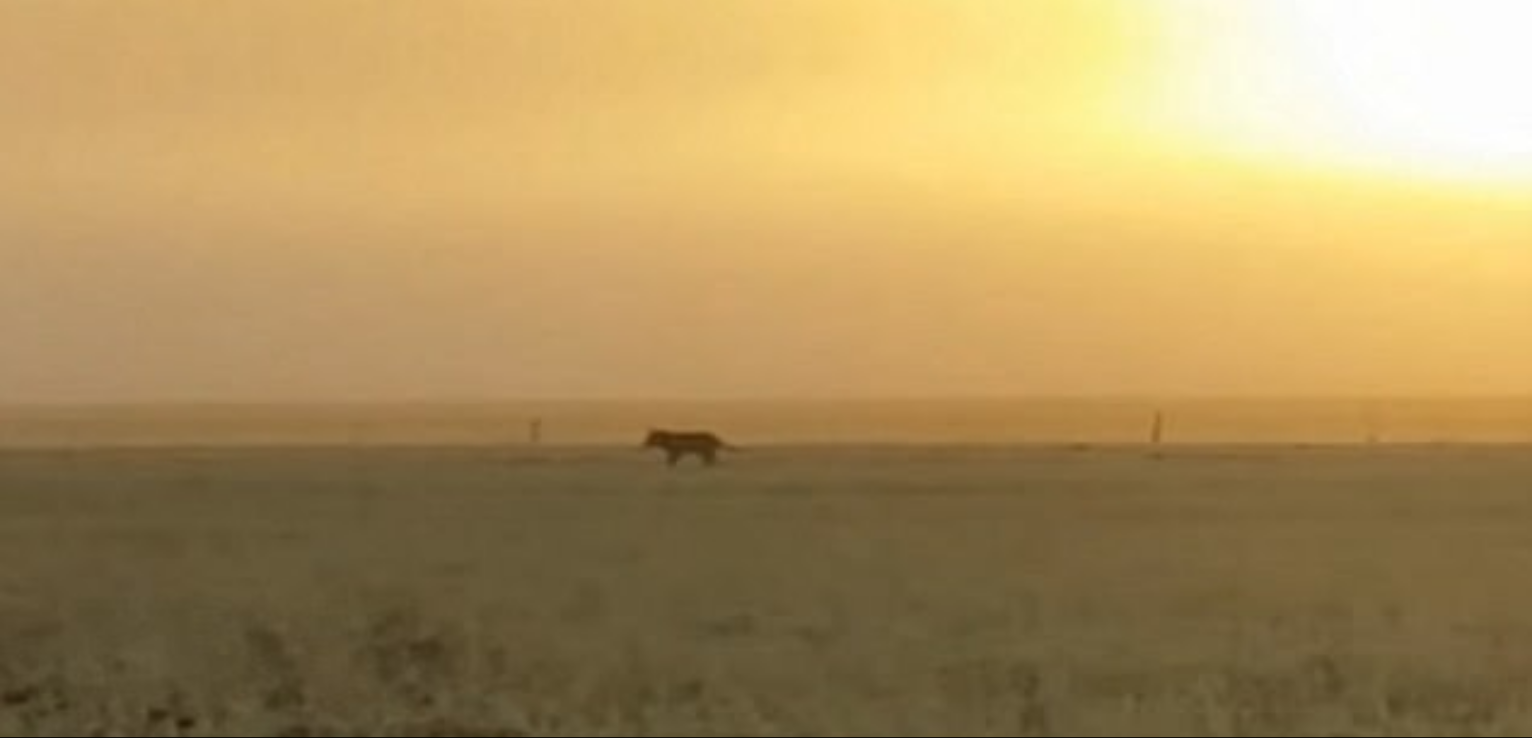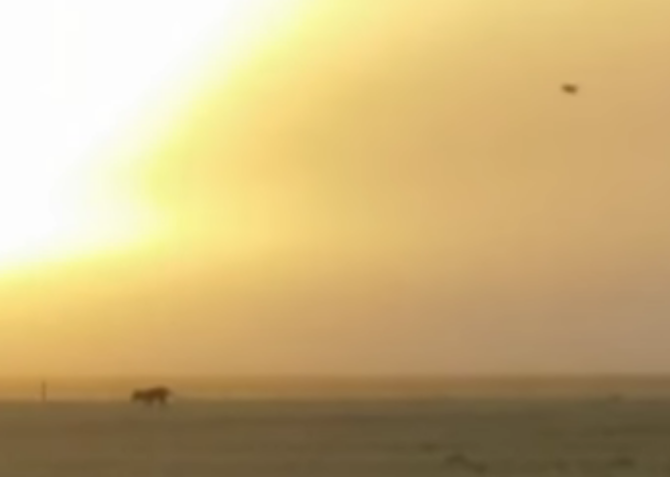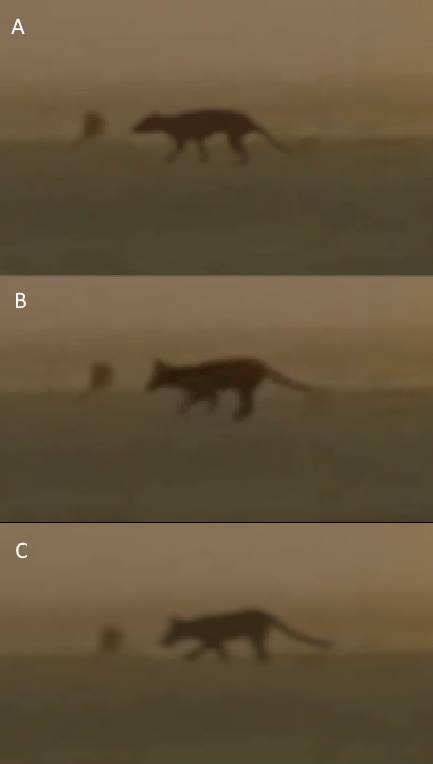Day thylacine - Moonta sunrise - further analysis
Chris Rehberg
Still frame from the Day thylacine film clip captured near Moonta at sunrise by Paul Day.
Overview
In July 2017 a short film clip was promoted amongst various media outlets purporting to show a prospective thylacine on mainland Australia running through a field against a sunrise. The location was given as "near Moonta" in South Australia and the videographer as Paul Day, a school teacher who also produces nature videos. Paul was scouting locations for filming a sunrise when he saw an animal run through the field, in front of the sunrise. Using his mobile phone he captured footage of this animal.
Summary of findings
My first impression - based solely on viewing on a mobile screen - was that this may have been prdouced using computer generated imagery (CGI). This was based on how the animal appeared to connect with the ground indistinctly. On review however, it is entirely feasible that given the limitation of the recording device, distance of the animal and nature of the ground cover (tall grass) that this is a normal representation under those conditions. Further, on reviewing the history of the publisher, who is known for producing nature videos, the credibility of the backstory is enhanced.
Some artefacts in the clip are difficult to explain, such as a pale streak along the length of the animal and a halo around the animal (and not around the bird). Explanations for these are speculative: mirage effects; limitations of the mobile phone camera that recorded the footage.
Taking the footage at face value, the animal's head turns toward the camera at the start of the footage and the animal appears to carry an injury in a hind leg (possibly on its right hand side). Public reactions vary: one social commentator claims experience with CGI analysis and that this is poorly executed CGI; another has mocked-up comparable still frames using both a fox and a composite image of thylacines in order to compare silhouettes and believes that fox is the best match (with images reproduced below, courtesy of Michael Curry); and a third has compared the animal's outline with that of a thylacine running animation to conclude the animal in Day's footage is a canid with hip dysplasia. This third analysis is included on WLMD as a guest post by Brendan Kays.
In my opinion the footage is likely to be genuine based on the credibility of the videographer, the animal carries a leg injury which is contributing to its seemingly unusual gait and the fox silhouette provides a better match than the thylacine silhouette. I concur with Kays' conclusion that the animal is probably a canid with hip dysplasia.
Examining the evidence
In an earlier article on WLMD, consideration was given to categories of evidence to consider when evaluating alleged evidence of the thylacine. These were:
- To consider properties of the evidence itself
- To check for similarity with historical documentation
- To consider the credibility of the back-story
- To consider the identity and credibility of the claimant
These categories relate more to ascertaining the credibility of the evidence than the identity of any animal. As such, a fifth is now added to the list:
- Identity of the unknown animal
Unusual artefacts in the footage
The first category of evidence to consider is the properties present within the evidence itself. In this section a number of artefacts within the footage are considered.
The first unusual artefact is that where the feet strike the ground, they are obscured by the grass. This may be expected of a genuine scene. However the grass does not appear to move. This may be explained by the resolution of the camera which was reported as being from a mobile phone, and/or the distance of the animal from the camera.
Secondly, there is a pale streak through the centre of the animal correlating approximately with the horizon. That said, the streak does move with the body of the animal if you inspect the footage frame by frame and is therefore more likely a function of the animal than solely the horizon. Ordinarily a highlight such as this should be the result of a bright light being reflected off the animal from the direction of the camera. In this particular case the rising sun is positioned behind the animal, with respect to viewer, and there is nothing obvious in the expansive foreground that should reflect that sunlight back onto the animal from the viewer's perspective. One possible explanation for this stripe is that it is an artefact introduced by the limits of the phone camera in use.
Thirdly, there appears to be a halo around the animal and this halo moves with the animal. This is most visible along the animal's back in both the screen grabs above and below but it does appear to encircle the entire silhouette of the animal.
The origin of this halo is not clear. It may be an optical effect of the light passing by the animal from the sunset behind it. The halo's tint, or colour, appears to match a thin strip of light just above the horizon. An expert on mirages and their effects on light near the horizon may be able to clarify further whether this is expected of real-world scenarios. As with the animal's stripe, the capabilities of the phone camera need to be kept in mind also.
A bird is seen flying through the clip but does not appear to show any similar halo. This is visible in the screen grab below, even at this low resolution, while the halo remains visible for the running animal. If the halo is a natural light effect then it is not likely due to the sun's position behind subjects, per se, but possibly due to the running animal's position directly in front of the horizon which itself shows a thin strip of similar colour.
One social commentator on Facebook had this to say: "The 'thylacine' video is unfortunately a hoax. I am a professional business consultant with a background in CGI analysis and the animal in the video has been digitally (and poorly) superimposed."
There are a number of artefacts in the clip that seem unusual and require further investigation for explanation.
The publisher
Two of the criteria for considering evidence of the thylacine are the identity and credibility of the claimant and the credibility of the back-story. Day's video was published under the Youtube account AuthorPaulGDay where there are dozens of other videos, many of them showing wildlife and many showing overlaid text. The back-story given was that he was scouting sunrise locations for a future shoot when he saw the animal running across the field of view and he decided to film it with the camera at hand - a mobile phone camera.
The video being examined here contains dramatic music and text overlays that are timed to the music. The end result presents more like a production piece than a random clip obtained while stopping to photograph a sunrise. However given the videographer's background in preparing such production pieces, this is perhaps consistent with what would be expected in this particular case and the back-story provides a credible context to how this footage was obtained.
The publisher and back-story present as credible.
Similarity with historical documentation
No known footage of a running thylacine exists although footage of thylacines pacing zoo cages exist and an interpretive animation of the thylacine running has been produced and is visible in the online Thylacine Museum. In analysing this evidence, one commentator mocked up a composite image of a running thylacine using four historical photographs to create a mocked-up still frame comparison using known thylacine images (discussed further below). Although it may be possible this video is a composite of such still frames, that seems very unlikely - especially as the animal's head turns toward the camera near the start of the clip; this is not just a simple repeated loop.
There is nothing obvious in this footage to suggest it incorporates any historical documentation.
Identification of the animal
There has been much online discussion regarding the identification of this animal with the majority of opinions falling into these identifications:
- A thylacine
- A fox
- A canid / dog
... each with or without an injury that causes an unusual gait.
Morphology
Identifying a species through morphology alone when using low quality imagery is necessarily a difficult process. Several published academic opinions affirm this - both for Day's video and mystery animal identification in general. Even amongst enthusiast groups such as bird watchers or aquarists, it is commonly stated that a particular aspect of morphology on its own can be insufficient for an identification (eg. colour, size, etc).
That said, an analysis of morphology may be able to exclude an identification on the basis of an impossible presentation - but caution should still be used as the orientation of a camera with respect to the animal can still lead to vastly different appearances for a given animal specimen, let alone varying animals within a species. A good example is that while thylacine ears are commonly described as rounded, even a rounded ear can be photographed from an angle that makes them appear pointed.
In the case of Day's footage, we have essentially a silhouette. Michael Curry, FEAR Lab, University of New England has produced a number of silhouette images for comparison with Day's footage. Curry has created a silhouette for the red fox using a photograph of a fox, and a silhouette for the thylacine using a composite imge he compiled from four historical photographs of the thylacine. These are presented with permission below.
Michael Curry's composite showing silhouette's from: A = thylacine; B = Day's footage; C = fox.
By inspection, and without measurement, the head proportions of Day's footage (B) arguably better match that of the fox (C) than the thylacine (A). As noted above, morphology can be an unreliable indicator on its own.
Gait
The thylacine is often described as having a loping gait. While there is no verified footage of a running thylacine, there is a computer generated animation sequence that relies heavily on scientific analysis of thylacine morphology and historical accounts. People also often note the loping gait of the thylacine's nearest living relatives - Tasmanian devils and quolls - and surmise the thylacine might have appeared similarly. These gaits are notably different than what is normal for a dog or fox. As such, gait becomes an important consideration even though historical documentation is limited in this regard.
Brendan Kays has produced an article analysing the Day thylacine's gait. This is quite comprehensive and demonstrates that the animal in Day's footage is carrying a limp. This is a conclusion with which I concur and the limp is the most likely explanation for the unusual gait observed in Day's footage. While illness or injury causing such a gait may plausibly affect the thylacine just as equally as a dog or fox, the limp does mean that we can't conclude the animal is a thylacine from its gait.
Historical distribution
Day's footage was filmed in South Australia. The general scientific consensus is that the thylacine died out on mainland Australia more than 2,000 years ago.
Robert Paddle, in his book The Last Tasmanian Tiger presents a number of historical anecdotes that suggest the thylacine may have persisted in eastern South Australia (and also in New South Wales) until approximately the 1830s (at least). Scientific opinion is generally divided on the merit of this evidence with some asserting there is a good case for mainland persistence until at least European arrival while others maintain the earlier extinction date, especially in the face of a lack of persistent specimen material that can be categorically dated as more recent than 2,000 years before present.
As such, the consensus opinion is that the species is extinct on mainland Australia which makes the scenario of Day's animal being a thylacine more implausible (though still not impossible).
Conclusion
The footage presents as a credible recording of a quadrupedal mammal running across the field of view. There are artefacts within the footage that are notable and warrant further examination. Without a rigorous analysis, the morphology of the animal appears to match a fox better than a thylacine. The animal's gait, which is notable, is more likely due to illness or injury than to the animal's identity being of marsupial origin. The sighting was made in an area not believed to have had thylacines for at least 2,000 years. Occam's Razor would suggest the animal is more likely a canid (eg. dog or fox) than a thylacine.
Acknowledgements
Thank you to Michael Curry for permission to include the mock-ups, and to Brendan Kays for his article contribution analysing the animal's gait.




